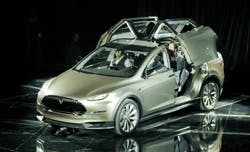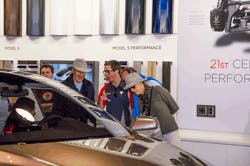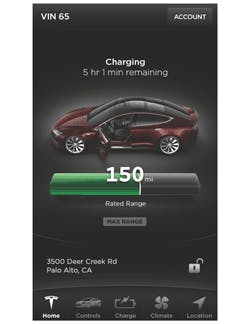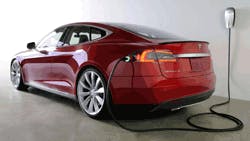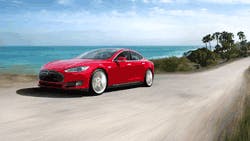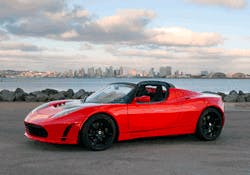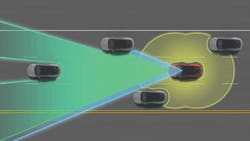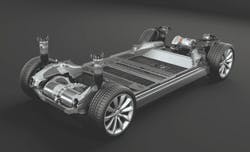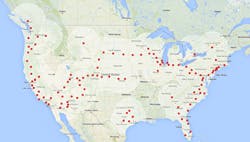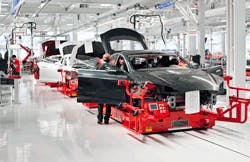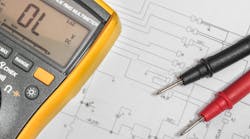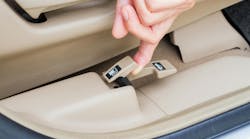On Oct. 10, 2014, Tesla CEO Elon Musk pulled back the wraps to unveil the latest Tesla offering, the Tesla S-D. The D stands for “dual motor” and heralds the introduction of All Wheel Drive (AWD) to the Tesla model line. Long been considered by many automotive enthusiasts a weakness to the standard Model S, the AWD version brings the Tesla closer to competing with other top-of-the-line nameplates with one very noticeable exception.
Choose the P85D (performance option), and your new Model S will come equipped with an 85kWh (kilowatts/hour) lithium-ion battery pack mated to a 221 hp electric motor on the front and a 470 hp sister on the rear. Together, the two electric drives will propel the Model S P85D from zero to 60 mph in 3.2 seconds and take it up to a top speed exceeding 150 mph. Drive it a little more conservatively, and the specs say you will go 265 miles between charges; remember, the Tesla is a Battery Electric Vehicle (BEV).
With a price tag topping $120,000, the P85D was to begin delivery to buyers in December 2014. The lower end offerings (the 60D and 85D) are scheduled for availability in February 2015. While the Model S seems to still offer the rear wheel drive only option, the AWD release removes that option to buyers of Tesla’s first SUV, the Tesla Model X, slated to be available later in 2015 or early 2016.
Its first car, the Roadster, was presented as a 2008 model and was the first fully electric sports car ever offered, as well as the first BEV to use a lithium-ion battery pack. The battery pack itself is unique in that it uses thousands of 18650 commodity cells rather than the more common, larger format, single purpose cells. They are a unique version of the 18650 cell that you might find in your laptop, but cheaper to manufacture and lighter than the conventional cell. The battery design allowed the Roadster to become the first EV to have a range greater than 200 miles. Since it’s introduction, Tesla has sold more than 2,300 Roadsters around the world.
Its current offering, the Model S, brought asking prices down significantly while offering a sporty sedan that could handle up to five occupants. Current sticker on a base Model S is $69,900, and it comes equipped with the 60 kWh battery and a single rear-mounted 380 hp motor. Rather than having the battery pack in the body, the Model S incorporates the battery in the floor of the vehicle, similar to the design of the prototype GM fuel cell skateboard. Tesla claims the battery pack can be changed out for a fresh one in less time than it takes to fuel a conventional car at the gas pump, and had plans to offer that option at some of its Supercharger locations. Overall, the car has done well, selling as many units in 2012 in North America as the Roadster had in its entire run.
What they can do, though, is service their products. It would seem that with no engine or conventional drive train, there is little left on a Tesla that would require conventional service or repair. Oh, there’s still steering and suspension to consider, as well as tires and brakes that wear out, but there’s a service plan for that. Unlike extended warranty service plans, Tesla customers can buy service plans that cover nearly every possible maintenance and repair need they may experience, excluding tires. Well, not quite. You can buy a winter set of tires all ready to install, if you want to.
Experienced technicians know that today, many performance and drivability issues are related to programming, requiring a reflash of the effected control module to correct. Tesla is no different, with nearly every system on their car electronic, but they do administer the reprogramming a little differently. Everything is done remotely, via wireless connection between the factory and the car. These updates not only address known performance issues, but they also allow the factory to update the software and firmware to the latest levels so the car actually improves with age. The process has more in common with updating your smart phone than it does reflashing an automobile.
The battery and electric drive units are warrantied for eight years and 125,000 miles on models using the 60 kWh battery pack, and that is increased to eight years/unlimited mileage when the 85 kWh battery pack is selected. In addition to the unlimited mileage, this option also includes at no charge access to Superchargers, Tesla’s network of charging stations across the world. This ever-growing network is sufficiently large enough (117 stations currently in the United States) to allow Tesla owners to drive across the country and certainly enough to support routine use on both the East and West coasts. Tesla claims their stations will provide an 80 percent charge in about 40 minutes, just enough time for the driver and his passengers to enjoy a meal and stretch their legs before resuming their journey.
As of this writing, I still don’t have an answer. And no, I never did get an invite to Sarasota.
Yes, I know. The Roadster is a $120,000-plus car and the odds of an owner popping into your shop wanting work done is not that likely. But there are those of you reading this article that make the majority of your living servicing high-end cars in your markets, and I thought it was a reasonable question to ask, especially afterAnd if the goal were to eventually build cars similar to the Audi A4 and BMW 3-series, wouldn’t it stand to reason that eventually they would need the services of the local shop? Yet there is no listing for access to service information that I could find, not even on the National Automotive Service Task Force’s (NASTF) website. I also poked around looking for scan tool offerings that would allow access to the Tesla’s systems and found nothing there as well.
And I think I know why. Consider first the EPA and California Air Resource Board’s (CARB) requirements for standardization among most cars under OBDII. It is, and always has been, a matter of emissions and environmental pollution. The Tesla, being an EV, has no emissions so it is exempt from meeting any such requirements. Now consider the wording of the Massachusetts Right To Repair legislation. It requires that automakers allow access to the same online service information they provide for their “dealers.” Tesla has no dealers, so technically this law (in its current form) does not apply to it either.
That may change, as Service Information Requests (SIRs) to NASTF from independent shops like yours increase, and more of you are asked to help Tesla owners who face out of warranty issues or exceptionally long down time waiting for factory help. If Tesla does come to realize its ambition of building useful EV cars for the “average” American, it will most certainly have to come to the realization that their products will be serviced at “average” American shops.
